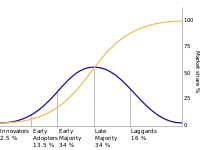
Photo from wikipedia
We develop methodology that allows peer effects (also referred to as social influence and contagion) to be modified by the structural importance of the focal actor's position in the network.… Click to show full abstract
We develop methodology that allows peer effects (also referred to as social influence and contagion) to be modified by the structural importance of the focal actor's position in the network. The methodology is first developed for a single peer effect and then extended to simultaneously model multiple peer-effects and their modifications by the structural importance of the focal actor. This work is motivated by the diffusion of implantable cardioverter defibrillators (ICDs) in patients with congestive heart failure across a cardiovascular disease patient-sharing network of United States hospitals. We apply the general methodology to estimate peer effects for the adoption of capability to implant ICDs, the number of ICD implants performed by hospitals that are capable, and the number of patients referred to other hospitals by noncapable hospitals. Applying our novel methodology to study ICD diffusion across hospitals, we find evidence that exposure to ICD-capable peer hospitals is strongly associated with the chance a hospital becomes ICD-capable and that the direction and magnitude of the association is extensively modified by the strength of that hospital's position in the network, even after controlling for effects of geography. Therefore, interhospital networks, rather than geography per se, may explain key patterns of regional variations in healthcare utilization.
Journal Title: Statistics in medicine
Year Published: 2020
Link to full text (if available)
Share on Social Media: Sign Up to like & get
recommendations!